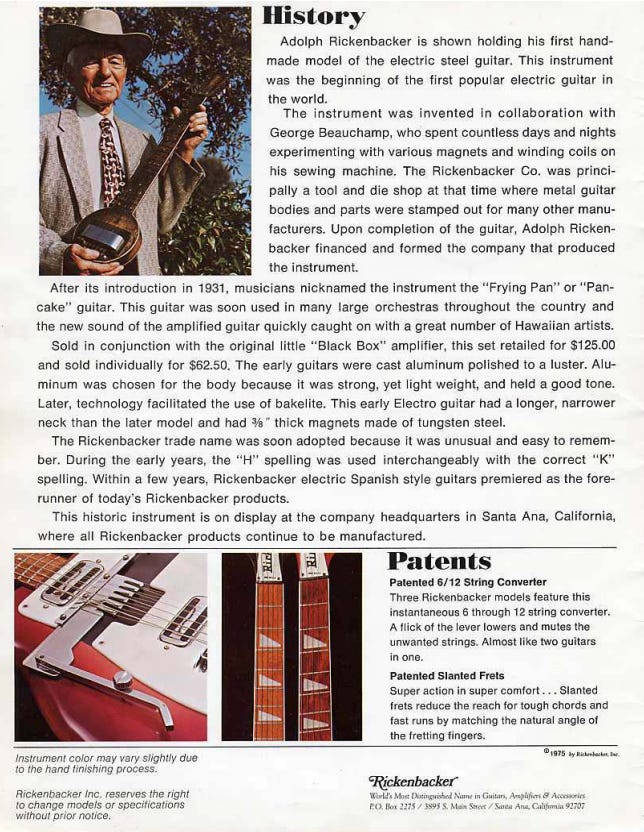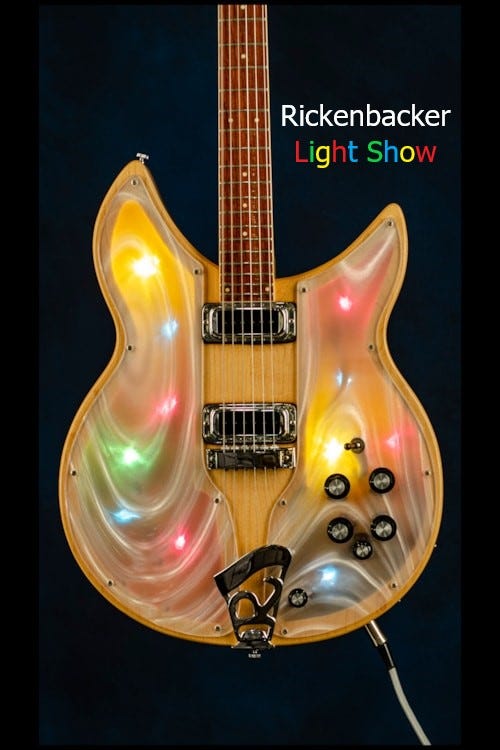Guitar Gavel Lick Of The Week with Marc Stamco - Bend & Blend
It's a double shot, bend and blend. That should be the name of a drink!
Thank you Marc for sharing your time, treasure, and talent! You can find more of Marc’s music at https://tinyurl.com/4ddwfy5p
"The Rickenbacker Light Show Guitar is without question one of the most bizarre and off-the-wall instruments ever manufactured - a guitar with inbuilt lights that flash in time with the notes and chords played… The Light Show was introduced as a brave new concept, something that had never been seen before and an all-out showstopper". (Tony Bacon. Rickenbacker Guitars - Out of the Frying Pan into the Fireglo pp.274-275).
Rickenbacker’s Viral Success
In 1958 Rickenbacker introduced the semi-hollow body Capri series, eventually evolving into the world renowned 300 series. They were largely designed by Roger Rossmeisl (formerly of Fender).
John Lennon played a 325 Capri on The Ed Sullivan Show in 1964. His 325 was from the very early 1958 production run and did not have the signature sound hole. Lennon had been playing it for several years at that point.
George Harrison played a 360/12 in the “A Hard Day’s Night” movie in 1964.
Roger McGuinn of The Byrds played a 360/12 on their debut album “Mr. Tambourine Man” in 1965.
The list keeps going, but those guys etched Rickenbacker in stone. In a 1989 interview with the Los Angeles Times, John Hall, President of Rickenbacker said, “When the Beatles came along, we went from selling thousands of guitars a year to tens of thousands.” Despite the guitar explosion of the mid 1960s, guitar sales across the industry were also declining by the end of the decade as imports flooded the market and musical tastes were beginning to change. Many manufacturers were looking for something new and different to spark sales and Rickenbacker was no different.
1970’s Experimentation
In an effort to generate sales and adapt to new musical tastes, Rickenbacker deployed a couple of changes and introduced their Hi-Gain pickups in 1969. Additionally, the 300 series guitars were offered with 24-frets alongside their traditional 21-fret counterparts.
And then came the Rickenbacker 331 Light Show (LS) in 1970. History portrays this as Rickenbacker’s attempt to capture the psychedelic music era and put it into a guitar. Most certainly, it was a guitar the world had never seen before…
Based on the same body style as the Rickenbacker 330 which debuted in 1958, the Ricky 331 had some literal Fireglo. Under the plexiglass top exists a set of multi-colored light bulbs that illuminated based on the pickup signal. Also known as “frequency modulated lamps”.
Red for treble notes, yellow or green for mid-range, and blue for bass.
An external transformer was needed to power the light bulbs and word on the street is this thing literally gets hot after playing for a while. There were two iterations of the model, the first had clear lights with filters, hand-wired sockets, and was the problematic “space heater”. The second version used colored bulbs with a circuit board and proved to be much more stable.
The guitar was cataloged through 1974 and it’s believed less than 100 units were ever made. It’s a little heavier and thicker than a standard 330, but delivers the same Ricky tone as others equipped with the Hi Gain pickups.
The 331 Light Show is the definitive Christmas guitar! Even the Grinch would have kept this one for himself. Fair market value for these range from $12,000 - $19,000 depending on condition and which iteration of the guitar is being offered (the 2nd version is more desirable, hence more expensive).
Rickenbacker 331 Light Show specs:
2” thick Maple body, Maple neck, Rosewood fretboard, Rosewood fretboard, Dual Hi-Gain pickups, Two volume and two tone controls, One blend and one light sensitivity control, 3-way switch, Rick-O-Sound stereo jack
Here’s a great 1-minute demo of the Light Show in action




1 comment
Love it! So unique and so off the reservation! Thank you.